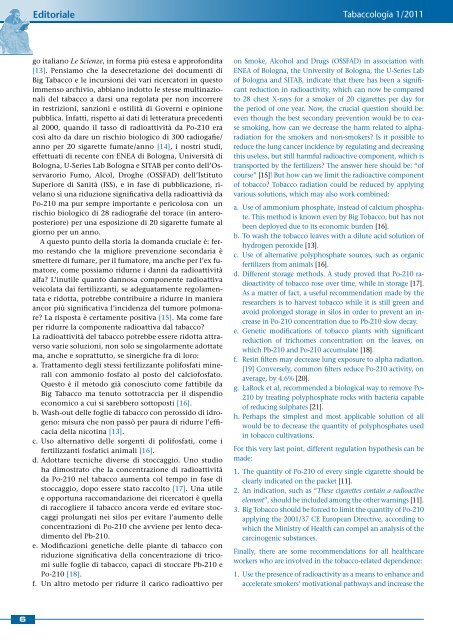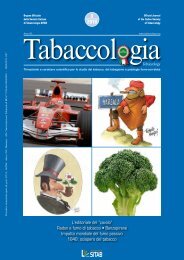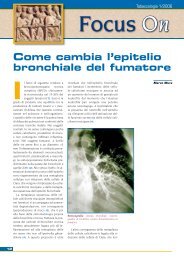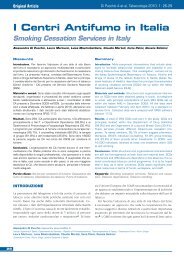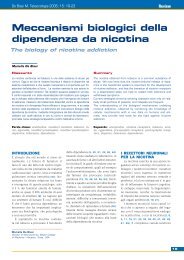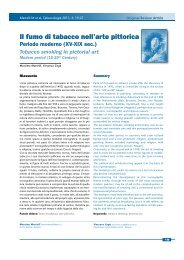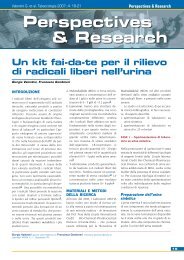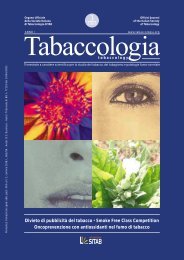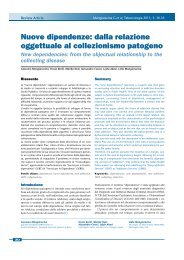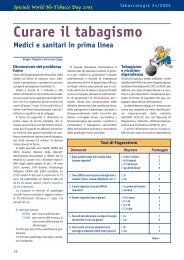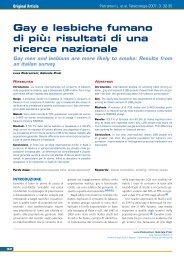Scarica n. 1/2011 - Società Italiana di Tabaccologia
Scarica n. 1/2011 - Società Italiana di Tabaccologia
Scarica n. 1/2011 - Società Italiana di Tabaccologia
You also want an ePaper? Increase the reach of your titles
YUMPU automatically turns print PDFs into web optimized ePapers that Google loves.
6<br />
E<strong>di</strong>toriale <strong>Tabaccologia</strong> 1/<strong>2011</strong><br />
go italiano Le Scienze, in forma più estesa e approfon<strong>di</strong>ta<br />
[13]. Pensiamo che la desecretazione dei documenti <strong>di</strong><br />
Big Tabacco e le incursioni dei vari ricercatori in questo<br />
immenso archivio, abbiano indotto le stesse multinazionali<br />
del tabacco a darsi una regolata per non incorrere<br />
in restrizioni, sanzioni e ostilità <strong>di</strong> Governi e opinione<br />
pubblica. Infatti, rispetto ai dati <strong>di</strong> letteratura precedenti<br />
al 2000, quando il tasso <strong>di</strong> ra<strong>di</strong>oattività da Po-210 era<br />
così alto da dare un rischio biologico <strong>di</strong> 300 ra<strong>di</strong>ogafie/<br />
anno per 20 sigarette fumate/anno [14], i nostri stu<strong>di</strong>,<br />
effettuati <strong>di</strong> recente con ENEA <strong>di</strong> Bologna, Università <strong>di</strong><br />
Bologna, U-Series Lab Bologna e SITAB per conto dell’Osservarorio<br />
Fumo, Alcol, Droghe (OSSFAD) dell’Istituto<br />
Superiore <strong>di</strong> Sanità (ISS), e in fase <strong>di</strong> pubblicazione, rivelano<br />
sì una riduzione significativa della ra<strong>di</strong>oattivià da<br />
Po-210 ma pur sempre importante e pericolosa con un<br />
rischio biologico <strong>di</strong> 28 ra<strong>di</strong>ografie del torace (in anteroposteriore)<br />
per una esposizione <strong>di</strong> 20 sigarette fumate al<br />
giorno per un anno.<br />
A questo punto della storia la domanda cruciale è: fermo<br />
restando che la migliore prevenzione secondaria è<br />
smettere <strong>di</strong> fumare, per il fumatore, ma anche per l’ex fumatore,<br />
come possiamo ridurne i danni da ra<strong>di</strong>oattività<br />
alfa? L’inutile quanto dannosa componente ra<strong>di</strong>oattiva<br />
veicolata dai fertilizzanti, se adeguatamente regolamentata<br />
e ridotta, potrebbe contribuire a ridurre in maniera<br />
ancor più significativa l’incidenza del tumore polmonare?<br />
La risposta è certamente positiva [15]. Ma come fare<br />
per ridurre la componente ra<strong>di</strong>oattiva dal tabacco?<br />
La ra<strong>di</strong>oattività del tabacco potrebbe essere ridotta attraverso<br />
varie soluzioni, non solo se singolarmente adottate<br />
ma, anche e soprattutto, se sinergiche fra <strong>di</strong> loro:<br />
a. Trattamento degli stessi fertilizzante polifosfati minerali<br />
con ammonio fosfato al posto del calciofosfato.<br />
Questo è il metodo già conosciuto come fattibile da<br />
Big Tabacco ma tenuto sottotraccia per il <strong>di</strong>spen<strong>di</strong>o<br />
economico a cui si sarebbero sottoposti [16].<br />
b. Wash-out delle foglie <strong>di</strong> tabacco con perossido <strong>di</strong> idrogeno:<br />
misura che non passò per paura <strong>di</strong> ridurre l’efficacia<br />
della nicotina [13].<br />
c. Uso alternativo delle sorgenti <strong>di</strong> polifosfati, come i<br />
fertilizzanti fosfatici animali [16].<br />
d. Adottare tecniche <strong>di</strong>verse <strong>di</strong> stoccaggio. Uno stu<strong>di</strong>o<br />
ha <strong>di</strong>mostrato che la concentrazione <strong>di</strong> ra<strong>di</strong>oattività<br />
da Po-210 nel tabacco aumenta col tempo in fase <strong>di</strong><br />
stoccaggio, dopo essere stato raccolto [17]. Una utile<br />
e opportuna raccomandazione dei ricercatori è quella<br />
<strong>di</strong> raccogliere il tabacco ancora verde ed evitare stoccaggi<br />
prolungati nei silos per evitare l’aumento delle<br />
concentrazioni <strong>di</strong> Po-210 che avviene per lento deca<strong>di</strong>mento<br />
del Pb-210.<br />
e. Mo<strong>di</strong>ficazioni genetiche delle piante <strong>di</strong> tabacco con<br />
riduzione significativa della concentrazione <strong>di</strong> tricomi<br />
sulle foglie <strong>di</strong> tabacco, capaci <strong>di</strong> stoccare Pb-210 e<br />
Po-210 [18].<br />
f. Un altro metodo per ridurre il carico ra<strong>di</strong>oattivo per<br />
on Smoke, Alcohol and Drugs (OSSFAD) in association with<br />
ENEA of Bologna, the University of Bologna, the U-Series Lab<br />
of Bologna and SITAB, in<strong>di</strong>cate that there has been a significant<br />
reduction in ra<strong>di</strong>oactivity, which can now be compared<br />
to 28 chest X-rays for a smoker of 20 cigarettes per day for<br />
the period of one year. Now, the crucial question should be:<br />
even though the best secondary prevention would be to cease<br />
smoking, how can we decrease the harm related to alphara<strong>di</strong>ation<br />
for the smokers and non-smokers? Is it possible to<br />
reduce the lung cancer incidence by regulating and decreasing<br />
this useless, but still harmful ra<strong>di</strong>oactive component, which is<br />
transported by the fertilizers? The answer here should be: “of<br />
course” [15]! But how can we limit the ra<strong>di</strong>oactive component<br />
of tobacco? Tobacco ra<strong>di</strong>ation could be reduced by applying<br />
various solutions, which may also work combined:<br />
a. Use of ammonium phosphate, instead of calcium phosphate.<br />
This method is known even by Big Tobacco, but has not<br />
been deployed due to its economic burden [16].<br />
b. To wash the tobacco leaves with a <strong>di</strong>lute acid solution of<br />
hydrogen peroxide [13].<br />
c. Use of alternative polyphosphate sources, such as organic<br />
fertilizers from animals [16].<br />
d. Different storage methods. A study proved that Po-210 ra<strong>di</strong>oactivity<br />
of tobacco rose over time, while in storage [17].<br />
As a matter of fact, a useful recommendation made by the<br />
researchers is to harvest tobacco while it is still green and<br />
avoid prolonged storage in silos in order to prevent an increase<br />
in Po-210 concentration due to Pb-210 slow decay.<br />
e. Genetic mo<strong>di</strong>fications of tobacco plants with significant<br />
reduction of trichomes concentration on the leaves, on<br />
which Pb-210 and Po-210 accumulate [18].<br />
f. Resin filters may decrease lung exposure to alpha ra<strong>di</strong>ation.<br />
[19] Conversely, common filters reduce Po-210 activity, on<br />
average, by 4.6% [20].<br />
g. LaRock et al, recommended a biological way to remove Po-<br />
210 by treating polyphosphate rocks with bacteria capable<br />
of reducing sulphates [21].<br />
h. Perhaps the simplest and most applicable solution of all<br />
would be to decrease the quantity of polyphosphates used<br />
in tobacco cultivations.<br />
For this very last point, <strong>di</strong>fferent regulation hypothesis can be<br />
made:<br />
1. The quantity of Po-210 of every single cigarette should be<br />
clearly in<strong>di</strong>cated on the packet [11].<br />
2. An in<strong>di</strong>cation, such as “These cigarettes contain a ra<strong>di</strong>oactive<br />
element”, should be included among the other warnings [11].<br />
3. Big Tobacco should be forced to limit the quantity of Po-210<br />
applying the 2001/37 CE European Directive, accor<strong>di</strong>ng to<br />
which the Ministry of Health can compel an analysis of the<br />
carcinogenic substances.<br />
Finally, there are some recommendations for all healthcare<br />
workers who are involved in the tobacco-related dependence:<br />
1. Use the presence of ra<strong>di</strong>oactivity as a means to enhance and<br />
accelerate smokers’ motivational pathways and increase the


